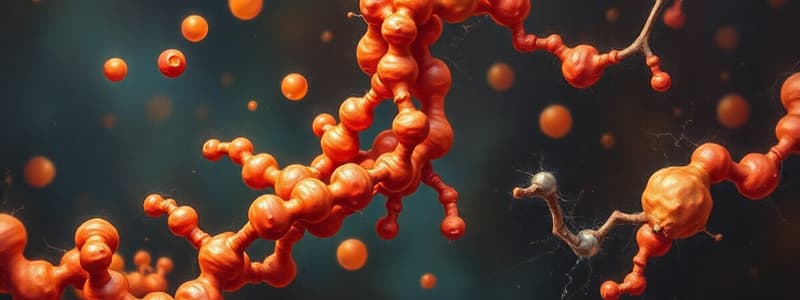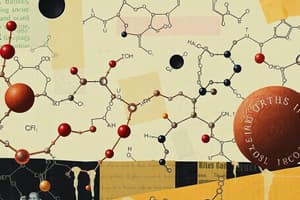Podcast
Questions and Answers
Which statement correctly describes the composition of proteins?
Which statement correctly describes the composition of proteins?
- Proteins are primarily composed of amino acids and carbohydrates.
- Proteins are only found in animal sources.
- Proteins consist solely of carbon and hydrogen.
- Proteins are organic substances made of carbon, hydrogen, oxygen, and nitrogen. (correct)
What defines a peptide in the context of protein chemistry?
What defines a peptide in the context of protein chemistry?
- A single amino acid molecule.
- A molecule consisting of two or more linked amino acid residues. (correct)
- A chain of more than 100 amino acids.
- A protein that contains only hydrogen and oxygen.
What is the maximum number of amino acid residues that can be found in a polypeptide?
What is the maximum number of amino acid residues that can be found in a polypeptide?
- Exactly 100.
- Less than 10.
- Between 10 and 100. (correct)
- More than 100.
Which of the following is classified as a dipeptide?
Which of the following is classified as a dipeptide?
Which bond is primarily responsible for the structure of proteins?
Which bond is primarily responsible for the structure of proteins?
What signifies the N-terminus in a peptide chain?
What signifies the N-terminus in a peptide chain?
Which of the following statements about protein denaturation is true?
Which of the following statements about protein denaturation is true?
What characterizes proteins that are classified as having a quaternary structure?
What characterizes proteins that are classified as having a quaternary structure?
What characterizes a peptide bond?
What characterizes a peptide bond?
Which statement about disulfide bonds is correct?
Which statement about disulfide bonds is correct?
What is the role of hydrophobic interactions in protein structure?
What is the role of hydrophobic interactions in protein structure?
What type of bond is primarily responsible for maintaining protein tertiary structure?
What type of bond is primarily responsible for maintaining protein tertiary structure?
Which is NOT a characteristic of peptide bonds?
Which is NOT a characteristic of peptide bonds?
Which interactions are classified as non-covalent bonds?
Which interactions are classified as non-covalent bonds?
Which of the following statements regarding the primary structure of proteins is incorrect?
Which of the following statements regarding the primary structure of proteins is incorrect?
Which of the following bonds can be easily separated or disrupted?
Which of the following bonds can be easily separated or disrupted?
What type of structure is characterized by the coiling of a polypeptide chain into a rod-like shape with 3.6 amino acids per turn?
What type of structure is characterized by the coiling of a polypeptide chain into a rod-like shape with 3.6 amino acids per turn?
What does not affect the peptide bonds in a protein structure?
What does not affect the peptide bonds in a protein structure?
Which of the following describes the bonds that stabilize tertiary protein structures?
Which of the following describes the bonds that stabilize tertiary protein structures?
Which statement about beta-pleated sheets is true?
Which statement about beta-pleated sheets is true?
What characterizes the quaternary structure of proteins?
What characterizes the quaternary structure of proteins?
Which factor is a cause of protein denaturation?
Which factor is a cause of protein denaturation?
What is the primary feature of tertiary protein structures?
What is the primary feature of tertiary protein structures?
Which of the following is a common feature of fibrous proteins compared to globular proteins?
Which of the following is a common feature of fibrous proteins compared to globular proteins?
What is a primary characteristic of globular proteins?
What is a primary characteristic of globular proteins?
Which of the following describes the denaturation of proteins?
Which of the following describes the denaturation of proteins?
Which type of protein contains all essential amino acids?
Which type of protein contains all essential amino acids?
What distinguishes conjugated proteins from simple proteins?
What distinguishes conjugated proteins from simple proteins?
What effect does denaturation have on the viscosity of proteins?
What effect does denaturation have on the viscosity of proteins?
Which statement about fibrous proteins is true?
Which statement about fibrous proteins is true?
Which protein classification is characterized by being deficient in one or more essential amino acids?
Which protein classification is characterized by being deficient in one or more essential amino acids?
What effect does denaturation have on the antigenic properties of proteins?
What effect does denaturation have on the antigenic properties of proteins?
Flashcards are hidden until you start studying
Study Notes
Proteins
- Proteins are organic nitrogenous substances made up of carbon, hydrogen, oxygen, and nitrogen.
- The fundamental building blocks of proteins are amino acids.
Peptides
- A peptide is a chain of two or more amino acid residues linked by peptide bonds.
- A dipeptide is formed when two amino acids are joined together.
- Tripeptides are formed when three amino acids are linked.
- Polypeptides consist of 10 to 100 amino acid residues.
- Proteins are polypeptides with more than 100 amino acid residues.
- Aspartame, a dipeptide formed by aspartate and phenylalanine, is used as a sweetener.
- Glutathione, a tripeptide constituted by glutamate, cysteine, and glycine, plays a key role in detoxification.
Peptide Chain Directionality
- The peptide chain is unbranched and directional, starting with an amino group (N-terminus) on the left and ending with a carboxyl group (C-terminus) on the right.
Bonds Responsible for Protein Structure
- Covalent Bonds:
- Peptide bonds
- Disulfide bonds
- Non-Covalent Bonds:
- Hydrogen bonds
- Hydrophobic interactions
- Electrostatic interactions
- Van der Waals interactions
Peptide Bond
- Formed through the condensation of two amino acids.
- The peptide bond is formed between the alpha amino group of one amino acid and the alpha carboxylic group of another amino acid, resulting in an amide bond.
Characteristics of the Peptide Bond
- Partial double bond character
- Rigid structure
- Short length
- Planar shape (no free rotation)
- Polar nature
- Uncharged
- Present in the trans form
Disulfide Bonds
- Occur between two cysteine residues in either the same polypeptide chain or different chains.
Non-Covalent Bonds
- Weak bonds easily separated.
Hydrogen Bond
- Attractive interaction between polar molecules where hydrogen (H) is bound to a highly electronegative atom, such as nitrogen (N) or oxygen (O).
Hydrophobic Interactions
- Nonpolar side chains of neutral amino acids tend to cluster inside the protein molecule (away from water).
- Polar groups, on the other hand, are typically located on the exterior of the protein molecule (exposed to water).
Protein Structures
- Primary Structure: The number, type, and sequence of amino acids in a polypeptide chain, linked by peptide bonds. Primary structure is not affected by denaturation.
- Secondary Structure: Folding or bending of the polypeptide chain into specific structures. It is maintained by interactions between amino acids close to each other through hydrogen bonds. The most common secondary structures are the alpha helix and beta-pleated sheet.
- Tertiary Structure: The three-dimensional structure of a protein (protein folding). Tertiary structure is formed by a combination of disulfide bonds, hydrogen bonds, hydrophobic interactions, and electrostatic interactions. The two main forms of tertiary structure are fibrous and globular proteins.
- Quaternary Structure: The arrangement of multiple polypeptide chains (subunits) joined together by non-covalent bonds. An example is hemoglobin, which has four subunits.
Denaturation of Proteins
- Loss of the quaternary, tertiary, or secondary structure of a protein while the primary structure remains intact.
- Can be reversible or irreversible.
- Causes of denaturation include physical agents (e.g., excessive heating or radiation) and chemical agents (e.g., strong acids or alkalis).
Effects of Denaturation
- Decreased solubility
- Increased viscosity
- Loss of biological activity
- Changed antigenic properties
- Easier digestion
Classification of Proteins
- Shape:
- Globular proteins: e.g., albumins and globulins
- Fibrous proteins: e.g., keratin, myosin
- Biological Value:
- High biological value: Complete set of essential amino acids.
- Low biological value: Deficient in one or more essential amino acids, e.g., gelatin and plant proteins.
- Structure:
- Simple Proteins: Formed only from amino acids e.g. albumin.
- Conjugated Proteins (Compound or Complex Proteins): Contain additional chemical components along with amino acids, e.g., hemoglobin.
- Derived Proteins e.g., gelatin.
Studying That Suits You
Use AI to generate personalized quizzes and flashcards to suit your learning preferences.




